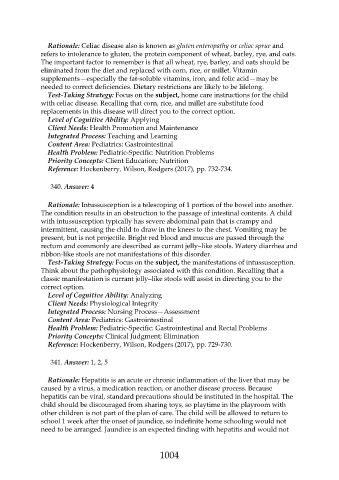Page 1004 - Saunders Comprehensive Review For NCLEX-RN
P. 1004
Rationale: Celiac disease also is known as gluten enteropathy or celiac sprue and
refers to intolerance to gluten, the protein component of wheat, barley, rye, and oats.
The important factor to remember is that all wheat, rye, barley, and oats should be
eliminated from the diet and replaced with corn, rice, or millet. Vitamin
supplements—especially the fat-soluble vitamins, iron, and folic acid—may be
needed to correct deficiencies. Dietary restrictions are likely to be lifelong.
Test-Taking Strategy: Focus on the subject, home care instructions for the child
with celiac disease. Recalling that corn, rice, and millet are substitute food
replacements in this disease will direct you to the correct option.
Level of Cognitive Ability: Applying
Client Needs: Health Promotion and Maintenance
Integrated Process: Teaching and Learning
Content Area: Pediatrics: Gastrointestinal
Health Problem: Pediatric-Specific: Nutrition Problems
Priority Concepts: Client Education; Nutrition
Reference: Hockenberry, Wilson, Rodgers (2017), pp. 732-734.
340. Answer: 4
Rationale: Intussusception is a telescoping of 1 portion of the bowel into another.
The condition results in an obstruction to the passage of intestinal contents. A child
with intussusception typically has severe abdominal pain that is crampy and
intermittent, causing the child to draw in the knees to the chest. Vomiting may be
present, but is not projectile. Bright red blood and mucus are passed through the
rectum and commonly are described as currant jelly–like stools. Watery diarrhea and
ribbon-like stools are not manifestations of this disorder.
Test-Taking Strategy: Focus on the subject, the manifestations of intussusception.
Think about the pathophysiology associated with this condition. Recalling that a
classic manifestation is currant jelly–like stools will assist in directing you to the
correct option.
Level of Cognitive Ability: Analyzing
Client Needs: Physiological Integrity
Integrated Process: Nursing Process—Assessment
Content Area: Pediatrics: Gastrointestinal
Health Problem: Pediatric-Specific: Gastrointestinal and Rectal Problems
Priority Concepts: Clinical Judgment; Elimination
Reference: Hockenberry, Wilson, Rodgers (2017), pp. 729-730.
341. Answer: 1, 2, 5
Rationale: Hepatitis is an acute or chronic inflammation of the liver that may be
caused by a virus, a medication reaction, or another disease process. Because
hepatitis can be viral, standard precautions should be instituted in the hospital. The
child should be discouraged from sharing toys, so playtime in the playroom with
other children is not part of the plan of care. The child will be allowed to return to
school 1 week after the onset of jaundice, so indefinite home schooling would not
need to be arranged. Jaundice is an expected finding with hepatitis and would not
1004

